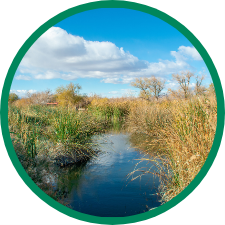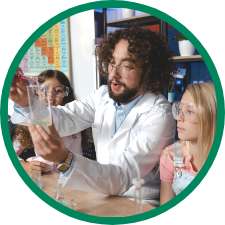April 16, 2021
National Environmental Education Week is the nation’s largest celebration of environmental education (or EE). This year, EE Week is April 19 – 23, 2021. It’s the perfect week to discover new environmental education resources and environmentally-focused activities to do with your students!
To celebrate #EEWeek, Project Learning Tree has partnered with the National Environmental Education Foundation (NEEF) to share a suite of EE and STEM-focused resources. To kick off EE Week 2021, we’re offering free youth access codes for PLT’s Find Your Green Job Personality Quiz to introduce youth to careers in sustainability and conservation. By answering a few simple questions online, students learn what their dominant personality trait is and receive suggestions for green jobs that they might be best suited to. Try the quiz yourself before using a version of this tool with your students and get up to 300 student codes for free. Visit PLT’s Shop and enter the code EEWEEK at checkout. This 100% off discount will expire on April 30.
NEEF has also organized a variety of live webinars and recorded events for EE Week 2021. Use the following activities to engage your students in learning about nature every day of the week and inspire the next generation to appreciate and care for the environment.
 Monday, April 19th: Citizen Science (Community Science) Tools for Teachers
Monday, April 19th: Citizen Science (Community Science) Tools for Teachers
Citizen science, also known as community science, allows members of the public to contribute to large-scale collaborative projects alongside trained scientists. These projects help researchers collect larger datasets and they help improve scientific literacy outside the formal science community.
To start EE Week this year, NEEF is holding a live webinar on Monday, April 19th at 2 PM EDT, Getting Your Citizen Science Project Off the Ground. This workshop will will walk participants through the process of creating, developing, and implementing an easy and accessible citizen science project.
If you don’t want to design a brand-new project, there are plenty of existing citizen science projects that your students can join through Zooniverse, SciStarter, or CitizenScience.gov. With a vast array of thousands of projects to choose from, your students are certain to find a project that suits their interests.
For example, FrogWatch USA, an initiative of the Association of Zoos & Aquariums, is an amphibian-focused citizen science project that enlists and trains volunteers to recognize different frog and toad calls, while also teaching volunteers about local wetlands in their community. To introduce your students to the amazing diversity of life on Earth and how plants and animals are connected to one another, try these activities from PLT’s new Explore Your Environment: K-8 Activity Guide: Charting Biodiversity and Web of Life.
Another interesting citizen science project is Budburst, a project of the Chicago Botanic Garden. Using the Budburst App, participants can explore natural areas and detail information about local plant species. The information collected is then used to study plants and pollinators to understand how the environment is responding to climate change. This plant-focused citizen science project can be used alongside the Bursting Buds and The Closer You Look activities from PLT’s new Explore Your Environment: K-8 Activity Guide.
The Lost Ladybug Project by Cornell University is another citizen science project your students could participate in. They can go outside to look for ladybugs in their neighborhood, photograph them and upload their digital pictures to help researchers understand the movements and health of different species of ladybugs, including what habitats they can be found in. Try this citizen science project as part of a larger lesson with the Get Outside!, Did you Notice?, and Peppermint Beetle activities from PLT’s new Explore Your Environment: K-8 Activity Guide.
 Tuesday, April 20th: Greening STEM in the Field
Tuesday, April 20th: Greening STEM in the Field
The next two days of EE Week are focused on Greening STEM, a teaching framework that applies science, technology, engineering, and math (or STEM) to discussions about the natural environment. NEEF is offering a recorded event, Experience Nature from the Classroom (available starting April 19th), that details how to use Chronolog.
Chronolog compiles images taken by citizen scientists to create a time-lapse of an environmental area, which allows for long-term ecological monitoring and storytelling. Use Chronolog with your students to explore a nearby outdoor environment and view the time-lapse to which their pictures are added.
 Wednesday, April 21st: Greening STEM for the Classroom
Wednesday, April 21st: Greening STEM for the Classroom
NEEF is offering a live webinar in partnership with the Forest Museum of Science, Greening in a Classroom Setting, on April 21st at 1 PM EDT to highlight ways to add STEM into your teaching, for example, biodiversity resources adapted to virtual learning. For other ways to get started, NEEF has a Greening STEM Hub full of practical lessons in STEM that focus on real-world challenges within the natural environment.
PLT activities support STEM education by presenting real-world opportunities to apply science, technology, engineering, and math in problem-solving. Check out our STEM Strategies, a series of articles that provide lots of ideas for enriching activities found in PLT’s PreK-8 Environmental Education Activity Guide, such as:
- Trees as Habitats: Students explore why snags make great habitats for birds, mammals, insects, fungi, amphibians, and reptiles.
- Pollution Search: In this activity, students learn about five different types of pollution and ways to reduce our impact on the environment.
- Picture This!: Students explore why some organisms live in many environments while others can only be found in very unique places.
 Thursday, April 22nd: Earth Day 2021
Thursday, April 22nd: Earth Day 2021
Since 1970, the global Earth Day movement has engaged more than 1 billion people to act and make collective changes to care for our environment.
The theme for this year is “Restore Our Earth”, focusing on using innovative methods and technology to help restore our planet’s ecosystems. Environmental restoration can take many forms, including the use of native plants (plants that exist in an environment naturally) to restore landscapes, provide habitat and food for native species, and support endangered wildlife. Check out PLT’s Educator Tips article Earth Day 2021 – Restore the Earth with Native Plants to explore the differences between native, non-native, and invasive plants; how invasive plants threaten the environment and why native plants sustain it — and bookmark a host of ideas to involve your students on Earth Day.
Looking for additional resources to help your students celebrate? EarthDay.org has an Earth Day Action Toolkit full of activity ideas and social media content to help make a difference on this special day and all other days of the year. NEEF also highlights the City Nature Challenge, a competition to engage the most people, make the most observations in nature, and find the most species in cities across America. City Nature Challenge 2021 takes place after EE Week from April 30 – May 9. Build on the momentum from EE Week and engage your students in this fun challenge and compete against students in other cities!
 Friday, April 23rd: Climate Change
Friday, April 23rd: Climate Change
Climate change may be the single biggest challenge that faces our planet today. It impacts many aspects of the daily lives of all living beings, including food and water availability, pollution, weather, and natural disasters. NASA’s Climate Kids is an excellent starting resource to allow your students to explore big-picture questions about climate, such as: what is the difference between climate and weather?
To wrap up National Environmental Education Week, NEEF will present two recorded events, How to Talk to Your Kids about Climate Change and Tips for Teaching Students about Climate Change (available starting April 19th). Learn new ways to introduce this important and complex topic to your students and open a discussion about ways students can have a positive impact on the global climate.
PLT’s new Explore Your Environment: K-8 Activity Guide lists ten activities for students in grades 3-8 to explore aspects related to global climate change. This article Teaching About Climate Change lists some other PLT units for middle and high school students to explore both the scientific and the social aspects of climate change. Forests are one of our most important tools for fighting climate change and the 12 free activities included in PLT’s new Learn About Forests toolkit offer simple suggestions for leading learners ages 10–16 in themes related to sustainable forest management and stewardship, including:
- Seeking Sustainability: This activity allows students to explore sustainable forestry and make connections to the United Nation’s Sustainable Development Goals.
- Trees in Trouble: This activity allows students to assess trees for signs of unhealthy symptoms and learn about different causes of poor tree health.
- Water Wonders: This activity allows students to model the different stages of the water cycle and explore how these stages are impacted by climate change.
Stay connected, virtually!
Throughout National Environmental Education Week, share your experiences and memories on social media using the hashtags #EEWeek and #ForEnviroEd and be sure to tag PLT – we would love to see how you are celebrating!
![]() Facebook: @projectlearningtree
Facebook: @projectlearningtree
![]() Twitter: @PLT
Twitter: @PLT


